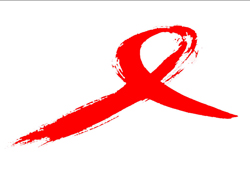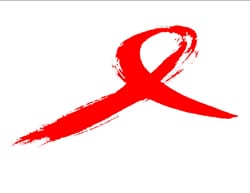How HIV stigma is damaging our community today… and at least one way it could serve a higher purpose
By Lawrence Ferber
Editor’s Note: Some of the names and some details in this article have been changed.
Stigma: a mark of disgrace associated with a particular circumstance, quality, or person.
Hearing the words “I’m HIV-positive” made Bryan freeze.
 A 23-year-old graphic designer, Bryan had met a guy at a Manhattan gay club, a svelte 25-year-old tourist named Zach, with whom he danced, drank and laughed. Around 1 a.m., just before heading to Zach’s hotel for more private activities together, the tourist disclosed his positive HIV status.
A 23-year-old graphic designer, Bryan had met a guy at a Manhattan gay club, a svelte 25-year-old tourist named Zach, with whom he danced, drank and laughed. Around 1 a.m., just before heading to Zach’s hotel for more private activities together, the tourist disclosed his positive HIV status.
His viral load was undetectable, successfully suppressed with a drug regimen to the point that there was low to no risk for transmission. He was clear of other STDs, and he had packed an ample supply of condoms.
Still, Bryan declined to go back with him, offering up a politely worded excuse rather than saying what he really thought: “I don’t sleep with HIV-positive guys.”
But Zach had heard those words, or variations on them, more than a few times since he had diagnosed a couple of years before. And he could see thetruth clearly in Bryan’s green eyes.
He felt like shit — judged and tainted. But while Zach wouldn’t lie and tell someone he was negative, he understood why so many others in his shoes did.
Bryan ended up hooking up later that same night at another bar with an architect-in-training from Chicago named Alex, who said he was negative.
Here’s the twist: When he turned Zach down that night, Bryan was actually already HIV-positive, even though he didn’t find out until about six months later. That’s when he went in and got tested for the first time in three years, having put off being tested because he was afraid of what he might find out, thanks to a bareback encounter with a man he met on Grindr, a man who deleted his Grindr profile the next day, disappearing as if in a puff of smoke.
****
Matthew Rodriguez with the comprehensive HIV/AIDS resource website The Body, noted: “Stigma is really damaging on both ends. For negative people, stigma can sometimes stop them from getting tested. If they feel they did anything that put them at risk, they may not want to get tested because the result may be devastating.
“I think it also stops people from interacting with those living with HIV as full people,” he continued. “People just look at you as a status, as a virus. It can also stop people from going to the doctor or seeking treatment, because that’s admitting they have the virus.”
At best, HIV stigma can lead to emotional sting, lost connections and deep blows to self-esteem. At worst, it can cause life and career-threatening discrimination and behavior that is dangerous and destructive to oneself and to others.
A recent study by Houston’s LIVE Consortium on the topic of HIV stigma within the gay/bisexual male community was published in the International Journal of Sexual Health. It concluded that, “Because it is realistic to expect that in a climate in which HIV has become increasingly invisible and closeted and in which infections are on the rise [due to stigma], gay and bisexual men will be increasingly affected and infected by HIV.”
Numerous organizations and campaigns are addressing HIV stigma, from those created exclusively for that purpose, including the two-year-old The Stigma Project and HIV Equal, to online resources like The Body, Avert.org, and HIV Plus, to hookup apps like MISTER.
The latter, in collaboration with Michigan’s Mr. Friendly HIV nonprofit, allows members to declare a commitment to “Live Stigma-Free” and date individuals of any HIV status on their profiles.
Despite these, stigma is only getting worse within the LGBT community, a fact LIVE’s disheartening study backs up.
Olympic gold medal diver Greg Louganis, who is himself HIV-positive, said: “I find often that stigma is self-imposed, out of undeserved and unwarranted shame and guilt.”
Louganis has HIV-positive since the 1980s, and his life is chronicled in the new documentary, Back On Board, currently making the rounds at festivals.
“The biggest problem is it inhibits open communication,” Louganis said, “and we still in this society have a difficult problem talking about sex.”
Longtime AIDS activist Peter Staley, a subject of David France’s Oscar-nominated documentary How To Survive A Plague, describes stigma as, literally, a “viral divide between those who perceive themselves to be negative and those who are positive. There are a lot of negatives to living with HIV the rest of your life — having to keep your health insurance in order, meds, side effects — but the big one now is the stigma.”
He continues, “I think a large number of negative men, especially if younger, try to avoid HIV just by avoiding people with HIV. They think they’re protected by a kind of moral code where a positive guy would disclose. On the flipside, the positive guys are so threatened by that stigma that they keep their status a secret, and that perpetuates the false assumption by many negative guys there isn’t a lot of HIV in their world.
“They think it isn’t something playing out in their generation that much, even though it is.”
New Yorker Steven Colon, a 21-year-old videogame design student diagnosed with HIV this past summer, now knows this sobering reality firsthand. Prior to his seroconversion — because he preferred barebacking with some partners, Colon opted for frequent HIV testing to keep tabs on his status — Colon only had sex with partners who identified as HIV-negative. He says he didn’t choose to have sex only with HIV-negative men; it was just that none of his partners ever told him they were positive.
After finding out he was HIV-positive, Colon contacted his sexual partners, but none of them have come forward to say they were actually positive or that they have tested positive since.
“It’s a little upsetting I don’t know who it is,” he admits.
Colon, who promotes a monthly superhero/spandex/lycra-themed party at NYC’s Pieces bar (called Skintight USA), found some immediate support amongst a couple of friends who, coincidentally, also tested positive at about the same time.
Staley feels that a major failing with most anti-stigma campaigns is that they “preach to the choir” and so fail to reach their target audiences — such as those gay millennials whose new infection rates are, as illustrated by Colon’s social cluster, rising.
On the ACT UP NY Alumni Facebook page last month, member Rebecca Reinhardt reported some flabbergasting, ill-informed comments and opinions she overheard at a West Hollywood happy hour for Ivy League 20-somethings.
These pearls of overheard misinformation included: “Condoms are useless, since they always break and you have only a 2 percent chance of getting HIV from unprotected sex anyway,” and PrEP “is a waste of money since it’s just for sex addicts anyway. “
Staley interjects, “I’m not wagging my finger at these guys. This generation of young gay men is no worse than mine. They’re just living in different times. When I was 20, I also perceived risk very differently, and was very dismissive of things that happened earlier in history and that I didn’t think applied to me.”
One exception when it comes to prevalence of stigma and misinformation seems to be San Francisco, where many early PrEP adopters live. Even those who argue that PrEP encourages reckless behavior that can cause upticks in other STD infections — like Hepatitis C — are at least having open communication.
“San Francisco is the shining example of where, if you put stigma on a locality ranking scale, you’ll find the least stigma of anywhere in the country,” Staley says. “They also have a very low HIV infection rate because guys there talk and think about HIV, and [use] a much more reasoned risk analysis.
“There will be a negative guy sleeping with positive guys, but asking about their viral load and making certain decisions determined by that,” Staley says. “That sophistication is lost on many young gay men outside San Francisco and New York City. I want to figure out the best way to reach them, and its likely going to come from [within] their generation, not mine.”
Activist Jack Mackenroth, who was open about his HIV-positive status while a contestant on Project Runway, agrees that it’s difficult to get people who don’t think — who don’t want to think — that HIV directly affects them engaged. He feels that once PrEP use grows more widespread, medical treatments advance and positive people become more visible, HIV stigma will dissipate.
Yet with stigma winning the battle today, is it possible to take this destructive force, reprogram it and somehow wield it for constructive, prevention-forward purposes? To replace fear and loathing with understanding and empathy, and to ultimately humanize HIV-positive individuals?
Perhaps — and in a handful of sizes.
“It would be useful to set someone down and say, ‘Imagine you are positive,’” Mackenroth muses. “You want to know what it feels like, wear a t-shirt saying you are positive all day long. You will know what that that’s like.”
That’s exactly what Kevin Maloney’s Rise Up To HIV is doing with its “No Shame About Being HIV+” T-shirts. Members of New York University’s First Year Queers & Allies leadership program wear these to experience reactions from those who would perceive their shirt as a status announcement.
It’s a start, and an experiment that more schools and colleges should look into.
“I’ve worn it and gotten mixed responses,” says Rodriguez. “Honestly, anyone can get HIV. The whole problem with stigma is [it perpetuates that] someone had to do something wrong to get HIV.
“But we know from science that with gay men, two-thirds of infections happen within the context of relationships,” Rodriguez continues. “I applaud people who don’t let status stand in the way of having a sexual relationship. It’s usually not the positive and on treatment guys one should be second-guessing. It should be the ones who don’t know. The only ones who know their status for sure are positive.”
















